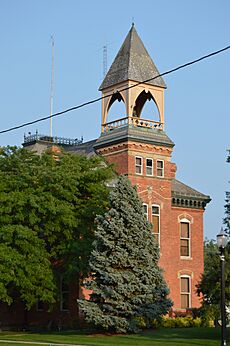Genoa, Ohio facts for kids
Quick facts for kids
Genoa, Ohio
|
|
|---|---|
|
Village
|
|

Genoa Town Hall
|
|

Location of Genoa, Ohio
|
|

Location of Genoa in Ottawa County
|
|
| Country | United States |
| State | Ohio |
| County | Ottawa |
| Government | |
| • Type | Council-manager government |
| Area | |
| • Total | 1.60 sq mi (4.13 km2) |
| • Land | 1.60 sq mi (4.13 km2) |
| • Water | 0.00 sq mi (0.00 km2) |
| Elevation | 627 ft (191 m) |
| Population
(2020)
|
|
| • Total | 2,232 |
| • Estimate
(2023)
|
2,193 |
| • Density | 1,398.50/sq mi (539.99/km2) |
| Time zone | UTC-5 (Eastern (EST)) |
| • Summer (DST) | UTC-4 (EDT) |
| ZIP code |
43430
|
| Area code(s) | 419 |
| FIPS code | 39-29722 |
| GNIS feature ID | 2398950 |
Genoa is a small village located in Ottawa County, Ohio, United States. About 2,232 people lived there in 2020. The area was first called Stony Ridge. It changed its name to Genoa in 1856 and became an official village in 1868.
Contents
History of Genoa
Early Settlers and the Great Black Swamp
In 1835, Timothy and Cinderella Sherman were the first European settlers in the area that is now Clay Township. Other families soon moved into the Great Black Swamp. This area became known as Stony Ridge. It was likely named for the limestone rocks that stuck out of the ground.
The Railroad Arrives
Genoa exists because of a railroad decision. The Toledo, Norwalk, and Cleveland Railroad wanted to shorten its line between Toledo and Cleveland. Instead of connecting other towns, they decided to build a straight line through Stony Ridge. Work on the railroad began in 1851. By December 1852, the first passenger train traveled through the area.
Growth and New Industries
Stony Ridge quickly grew after the railroad arrived. Within two years, it had a saw mill, a post office, a hotel, and other businesses. People from the East Coast and Europe moved there, and churches were started. Genoa became famous for its limestone. Quarries in the area began sending "Genoa White Lime" across the region using the new railroad.
Renaming the Village
In the spring of 1856, Stony Ridge was renamed Genoa. This change likely happened to avoid confusion with another Stony Ridge, Ohio, which was only seven miles away. That same year, the first Genoa school was built. This building is still standing today and is known as Heritage Hall.
Genoa During the Civil War
When the Civil War began in 1861, many people were asked to join the army. Genoa had a railroad station, which connected it to the outside world. More than one hundred people from Genoa joined different army groups. In 1862, a newspaper called the Toledo Blade said that "few towns have done as well as Genoa in furnishing troops for the Union Army."
Becoming an Official Village
After the Civil War, Genoa grew even faster. In 1868, local people asked the Ottawa County Commissioners to make Genoa an official village. On December 10, 1868, Genoa officially became an incorporated village. In 1869, the village bought the old school house, and it became the village's town hall.
The Town Hall and Opera House
From 1883 to 1884, the village and Clay Township built a new two-story town hall and opera house together. By the 1970s, the building needed repairs. It was added to the National Register of Historic Places in 1976. It was then restored with a large grant of $755,000 in 1978-1979. Today, the Town Hall still holds the village council meetings, the mayor's office, and the Genoa Civic Theater.
Geography
Genoa is located in Ohio. According to the United States Census Bureau, the village covers a total area of about 1.55 square miles (4.01 square kilometers). All of this area is land.
Population Information
| Historical population | |||
|---|---|---|---|
| Census | Pop. | %± | |
| 1870 | 558 | — | |
| 1880 | 930 | 66.7% | |
| 1890 | 839 | −9.8% | |
| 1900 | 824 | −1.8% | |
| 1910 | 817 | −0.8% | |
| 1920 | 971 | 18.8% | |
| 1930 | 1,437 | 48.0% | |
| 1940 | 1,455 | 1.3% | |
| 1950 | 1,723 | 18.4% | |
| 1960 | 1,957 | 13.6% | |
| 1970 | 2,139 | 9.3% | |
| 1980 | 2,213 | 3.5% | |
| 1990 | 2,262 | 2.2% | |
| 2000 | 2,230 | −1.4% | |
| 2010 | 2,336 | 4.8% | |
| 2020 | 2,232 | −4.5% | |
| 2023 (est.) | 2,193 | −6.1% | |
| U.S. Decennial Census | |||
Population in 2010
In 2010, Genoa had 2,336 people living in 944 households. The average number of people in each household was 2.38. The average age of people in the village was 40.6 years old. About 22.9% of residents were under 18 years old. Also, 19.3% of residents were 65 years or older. The population was almost evenly split between males (48.9%) and females (51.1%).
Education
The Genoa Area Local School District serves the village. It includes one elementary school, one middle school, and Genoa Area High School.
Notable People
- Joe Mahr, an investigative reporter.
- Harold McMaster, who founded several companies like Permaglass Inc. and Glasstech, Inc.
- Bill Nolte, a Broadway actor known for his role in Cats.
- Bryan Smolinski, a professional hockey player who played college hockey at Michigan State University.
See also
 In Spanish: Genoa (Ohio) para niños
In Spanish: Genoa (Ohio) para niños

